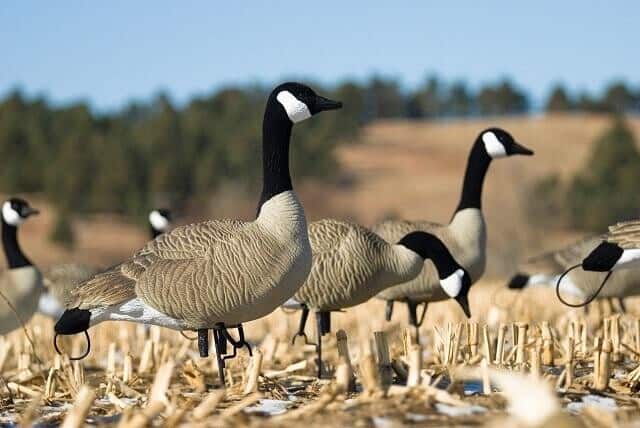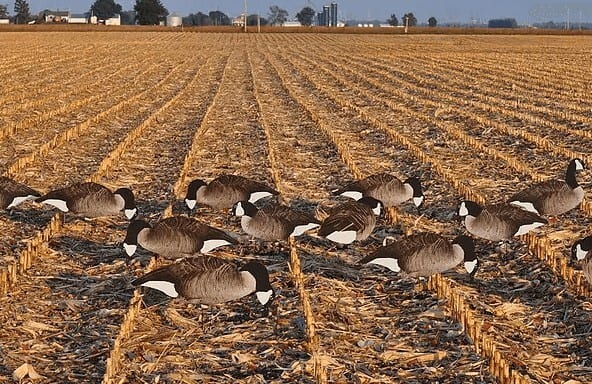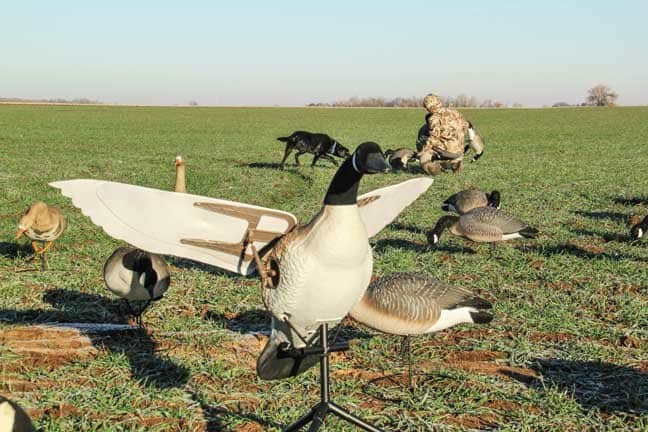Hunters always want to use the best possible tactic when hunting. Bonus points if it is cost-effective. So if we are trying to develop a decoy spread, we have quite a few types of decoys we can choose from. The biggest question to answer is if you should use mostly silhouettes, full bodies, or a mix of both. To answer that question, I asked 120 hunters online what they use in their spreads.
Silhouette and full-body decoys are both great options that will bring in geese. However, silhouette decoys tend to be favored due to their small price tag. Although full-body decoys are more realistic than their 2D counterparts. Generally, a good spread will consist of a mix of both of these decoys.

With that being said, there is much more to it than a price tag. Let’s take a look at what 120 hunters had to say and the reasons behind their conclusions.
Survey Says…
To conduct this survey of the hunting community, I basically went around on forums and Facebook posts where people were asking about whether they should get silos or full-body decoys, as well as posts asking what other hunters were using in their spreads.
Then I just tabulated every time someone said “you should get X” or “use both”, or when they said, “I use XYZ in my spread”. After 120 responses, I plugged the numbers into this pie chart so you could see the percentages.
As you can see from the chart, most hunters are mainly using silhouette decoys, or are at least using a mix of silos and full bodies. Many of the hunters that said they used a mix also mentioned that they used shells, socks, and even had a few flags in there too.
Anytime a new hunter asked what they should get to fill their spread the unanimous answer was always Dive Bomb Silhouettes. The awesome price tag on these decoys just allows hunters to buy a few dozen and make a large spread. Although, if a hunter already had some other types of decoys, it was recommended that they get the dive bombs, but continue to mix in the others.
Full-body decoys were also very popular. There were plenty of hunters that overcame the price hurdle by making their own decoys. As for hunters that were a little more invested in their consumer full body decoys, they said their decoys worked wonders and were very realistic.
The bottom line is that out of these 120 hunters, no two spreads were the same and there is not one perfect combination. Plus, all of these hunters were getting geese to come into their spreads, so something is working right.
If you are trying to fluff up your spread or build a brand new one, let’s take a closer look at silos and full bodies and see how each of them can benefit you.
Pros & Cons of Silhouette and Full Body Decoys

Price
Seeing as silo decoys are still good decoys that get the job done, the price is what makes most hunters go for them. To buy a dozen full body decoys you can easily spend over $400 for some mid-range decoys. On the other hand, silos are $86 for a dozen. So if you can have 4 – 5 times as many decoys for the same price, it’s kind of a no-brainer.
Full-body decoys are nice, and if you can find some cheaper ones that still look good, then they may be worth picking up. Used full-body decoys have become a whole sub-market in the waterfowl world. Since they are typically so expensive, you can often find some used ones that will work just as well as the new ones. You could get an even better deal if you find decoys that need a little TLC, with a little paint and sealant, old decoys can look just as good as new ones.
Realism
When it comes to realism, 3D full bodies are obviously king, but do these cheap 2D decoys really hold up against their 3D counterparts when it comes to realism? Well, yes and no. Because these silos are 2D, from certain angles geese cannot see them at all and at other angles, they are fully broadside and look as good as a 3D decoy. This is the reason you need more silhouette decoys than full-body decoys.
With full bodies, you can afford to have about one or two dozen decoys if you only have a few hunters and want to bring in a good amount of birds. To get the same effect with silos, you just simply need more decoys. Which is not really a problem because of the price. Although, I will say that the fact that you need more decoys does not make silos as expensive as full bodies to get the same effect.
Both of these types of decoys are very realistic and fool birds every single year. If you are wanting to try out silos for the first time, don’t worry, they will fool geese.
Motion

There are plenty of 3D motion options out there. You can have battery-powered decoys or wind-powered decoys that will move. Both of these are great, and they look super good. Although motion is an interesting topic when we are talking about silhouettes.
If you remember earlier, I was saying how while geese are flying above, they can see some silos and not others because of their angle of sight. Well, while they are circling above, that angle is constantly changing. With this effect of not seeing decoys and then seeing other decoys, it gives the illusion of movement.
Plus, this movement does not depend on the wind or battery power. It is just a coincidence of the physics of the 2D target, and it will always work. Again, is this “motion” better than a moving full body or other decoys? It is hard to say one is better than the other, but since silos do work well, price comes back into the argument.
Mobility
Mobility is yet another area where the silos shine. You can fit three dozen 2D silos where you could fit just a couple of full-body decoys. You can carry all these silhouettes in one hand and put them out in the field all in one go. Plus, cleaning up is also much easier, because you just have to pick them up like yard signs and they all pack up nicely.
I know I am not the only one that hates carrying around a huge bag of full body decoys, and lugging it around a field. Then you’ve got to go back and grab another bag, and another, and another… After a while, those lightweight and thin silos start to look a lot more appealing.
Creating a Mixed Spread
Something a lot of hunters said in the survey is if you already have a few dozen full bodies or other decoys, do not get rid of them, just mix them in with new silos. If you want to build a mixed spread, I recommend having around a dozen full bodies and 3 – 5 dozen silos depending on if you have any shells or socks mixed in there.
Mixed spreads are truly the way to go. They incorporate all the advantages of every type of decoy, and where some decoys lack, others shine through. So if you are starting from scratch, I would definitely get a bunch of silos, but do not overlook full bodies or shells.
Try and find a used dozen of full bodies online, they can be hard to find but they are worth having. Likewise, shells and socks can add a unique aspect to the spread so do not get tunnel vision on silhouettes or full bodies.
Spreads for Hunting Fields Vs Water
If you are hunting over water, it is going to be a little harder to use silhouettes. There are guys that make wooden frames that float with silos on them, but then they are just as hard to lug around as floaters. It may still be worth it for the price, but water spreads are a different ball game. Check out this video here of a hunter making his silos float
You are most likely hunting in a field if you want to use silhouettes. A great pattern to use in a field is the X or U pattern. It is super easy to make an X pattern with a few dozen silos and then throw in some full bodies near the middle. It is a super-effective strategy and is sure to have birds land in it.
Thank you for reading my article! I hope you enjoyed it, and if you have any questions or feedback, please send me an email at Patrick.Long@omegaoutdoors.net. If you want to learn more about me or Omega Outdoors, visit my About Page. Otherwise, I hope you have a great day, and check out some of my other articles while you’re here!
